Smellscape Characteristics of an Urban Park in Summer: A Case Study in Beijing, China
Abstract
1. Introduction
- (1)
- Enhancing Emotional Connection
- (2)
- Cultural and Identity Significance
- (3)
- Fostering Well-being and Comfort
- (4)
- Navigation and Spatial Awareness
2. Materials and Methods
2.1. Study Area
2.2. Smellwalk and Smellmap
2.3. Smell Classification
2.4. Construction of the Questionnaire
2.4.1. Information about the Interviewees
2.4.2. Visiting Experience
2.4.3. Individual Smell Identification
2.5. Statistical Analysis
3. Results
3.1. Smell Distribution Characteristics
3.2. Individual Smell Perception Analysis
3.3. Effects of Individual Smell Perception on Visiting Experience
3.3.1. Relationship between Smell Perception and Visual Experience Degree
3.3.2. Relationship between Smell Perception and Olfactory Rating
3.3.3. Relationship between Smell Perception and Overall Experience Degree
3.3.4. Correlation between Visit Experience Degrees
3.4. Effects of Social/Demographical/Behavioral Factors on Individual Smell Perception
4. Discussion
4.1. Differences in Smellscapes in Urban Parks and Urban Environments
4.2. Suggestions for Management and Design of Urban Park Smellscapes
5. Conclusions
Author Contributions
Funding
Institutional Review Board Statement
Informed Consent Statement
Data Availability Statement
Acknowledgments
Conflicts of Interest
References
- Anguluri, R.; Narayanan, P. Role of green space in urban planning: Outlook towards smart cities. Urban For. Urban Green. 2017, 25, 58–65. [Google Scholar] [CrossRef]
- Brown, R.D.; Vanos, J.; Kenny, N.; Lenzholzer, S. Designing urban parks that ameliorate the effects of climate change. Landsc. Urban Plan. 2015, 138, 118–131. [Google Scholar] [CrossRef]
- Chang, C.; Li, M. Effects of urban parks on the local urban thermal environment. Urban For. Urban Green. 2014, 13, 672–681. [Google Scholar] [CrossRef]
- Chiesura, A. The role of urban parks for the sustainable city. Landsc. Urban Plan. 2004, 68, 129–138. [Google Scholar] [CrossRef]
- Heidt, V.; Neef, M. Benefits of urban green space for improving urban climate. In Ecology, Planning, and Management of Urban Forests: International Perspectives; Springer: New York, NY, USA, 2008; pp. 84–96. [Google Scholar]
- Kaplan, R.; Kaplan, S. The experience of nature: A psychological perspective. In The Experience of Nature: A Psychological Perspective; Cambridge University Press: New York, NY, USA, 1989; p. 340. [Google Scholar]
- Vasilikou, C. Sensory Navigation in the City Centre. Perceptual Paths, Sense Walks and Interactive Atmospheres. In Proceedings of 3rd International Congress on Ambiances, Volos, Greece, 21–24 September 2016. [Google Scholar]
- Davidson, J.; Milligan, C. Embodying Emotion Sensing Space: Introducing Emotional Geographies. Soc. Cult. Geogr. 2004, 5, 523–532. [Google Scholar] [CrossRef]
- Zardini, M.; Schivelbusch, W. Sense of the City: An Alternate Approach to Urbanism; Canadian Centre for Architecture: Montréal, QC, Canada, 2005. [Google Scholar]
- Hussein, H. Sensory gardens: Assessing their design and use. Intell. Build. Int. 2010, 2, 116–123. [Google Scholar]
- Shoemaker, C.A.; Diehl, E. Interaction by Design: Bringing People and Plants Together for Health and Well-Being: An International Symposium; Iowa State Press: Ames, IA, USA, 2002. [Google Scholar]
- Kühne, O.; Koegst, L.; Edler, D. Theory and Meaning of Multisensory Landscapes. In Multisensory Landscapes: Theories and Methods; Koegst, L., Kühne, O., Edler, D., Eds.; Springer Fachmedien Wiesbaden: Wiesbaden, Germany, 2023; pp. 13–29. [Google Scholar]
- Vukovic, N.; Mingaleva, Z. Towards a Sustainable City with a Sensory Garden in the Context of Urban Well-Being. Sustainability 2023, 15, 4762. [Google Scholar] [CrossRef]
- Wartmann, F.M.; Frick, J.; Kienast, F.; Hunziker, M. Factors influencing visual landscape quality perceived by the public. Results from a national survey. Landsc. Urban Plan. 2021, 208, 104024. [Google Scholar] [CrossRef]
- Fry, G.; Tveit, M.S.; Ode, Å.; Velarde, M.D. The ecology of visual landscapes: Exploring the conceptual common ground of visual and ecological landscape indicators. Ecol. Indic. 2009, 9, 933–947. [Google Scholar] [CrossRef]
- Ulrich, R.S. Visual landscapes and psychological well-being. Landsc. Res. 1979, 4, 17–23. [Google Scholar] [CrossRef]
- Ou, D.; Mak, C.M.; Pan, S. A method for assessing soundscape in urban parks based on the service quality measurement models. Appl. Acoust. 2017, 127, 184–193. [Google Scholar] [CrossRef]
- Bahalı, S.; Tamer-Bayazıt, N. Soundscape research on the Gezi Park—Tunel Square route. Appl. Acoust. 2017, 116, 260–270. [Google Scholar] [CrossRef]
- Liu, J.; Wang, Y.; Zimmer, C.; Kang, J.; Yu, T. Factors associated with soundscape experiences in urban green spaces: A case study in Rostock, Germany. Urban For. Urban Green. 2019, 37, 135–146. [Google Scholar] [CrossRef]
- Liu, J.; Xiong, Y.; Wang, Y.; Luo, T. Soundscape effects on visiting experience in city park: A case study in Fuzhou, China. Urban For. Urban Green. 2018, 31, 38–47. [Google Scholar] [CrossRef]
- Tarlao, C.; Steele, D.; Blanc, G.; Guastavino, C. Interactive soundscape simulation as a co-design tool for urban professionals. Landsc. Urban Plan. 2023, 231, 104642. [Google Scholar] [CrossRef]
- Covarrubias, P.; Jiménez, Á.A.; Cabrera, F.; Costall, A. The Senses Considered as Perceptual Systems: The Revolutionary Ideas of Gibson’s 1966 Book, 50 Years Later—Part 1. Ecol. Psychol. 2017, 29, 69–71. [Google Scholar] [CrossRef]
- Bushdid, C.; Magnasco, M.O.; Vosshall, L.B.; Keller, A. Humans Can Discriminate More than 1 Trillion Olfactory Stimuli. Science 2014, 343, 1370–1372. [Google Scholar] [CrossRef] [PubMed]
- Porteous, J.D. Smellscape. Prog. Hum. Geogr. 1985, 9, 356–378. [Google Scholar] [CrossRef]
- Herz, R.S.; Engen, T. Odor memory: Review and analysis. Psychon. Bull. Rev. 1996, 3, 300–313. [Google Scholar] [CrossRef]
- Davis, L.; Thys-Şenocak, L. Heritage and scent: Research and exhibition of Istanbul’s changing smellscapes. Int. J. Heritage Stud. 2017, 23, 723–741. [Google Scholar] [CrossRef]
- Chen, Y.; Yuan, X. Study on the plant scentscape of the grand view garden in A Dream of Red Mansions. Chin. Landsc. Archit. 2017, 33, 88–92. [Google Scholar]
- Chen, Y.; Yuan, X. A study on the design philosophy of plant smellscape in gardens in lower Yangtze region in Ming and Qing dynasties. Archit. J. 2018, 2, 7–13. [Google Scholar]
- Kawasaki, M. Selection of 100 fragrance landscapes. Flavors Fragr. 2002, 9, 49–57. [Google Scholar]
- Zhang, X.; Guo, J.; Zhang, X.; Zhang, Q. Physiological Effects of a Garden Plant Smellscape from the Perspective of Perceptual Interaction. Int. J. Environ. Res. Public Health 2023, 20, 5004. [Google Scholar] [CrossRef] [PubMed]
- Huang, Y.; Yuan, X. Smellscape as a healing factor in institutional gardens to enhance health and well-being for older people with dementia: A scoping review. J. Clin. Nurs. 2023. [Google Scholar] [CrossRef] [PubMed]
- McLean, K.J. Nose-First: Practices of Smellwalking and Smellscape Mapping; Type, Royal College of Art: London, UK, 2019. [Google Scholar]
- McLean, K. Smellmap: Amsterdam—Olfactory Art and Smell Visualization. Leonardo 2017, 50, 92–93. [Google Scholar] [CrossRef]
- Xiao, J.; Aletta, F.; Radicchi, A.; McLean, K.; Shiner, L.E.; Verbeek, C. Recent Advances in Smellscape Research for the Built Environment. Front. Psychol. 2021, 12, 700514. [Google Scholar] [CrossRef]
- Feng, R.; Liu, L.; Ma, D.; Cheng, Q.; Long, Y. Urban Smellscape: A Dimension of Street Space Quality. Time Archit. 2017, 158, 18–25. [Google Scholar]
- Gao, Y.; Wang, C.; Huang, M.; Guo, W. A New Perspective of Sustainable Perception: Research on the Smellscape of Urban Block Space. Sustainability 2022, 14, 9184. [Google Scholar] [CrossRef]
- Çeven, E.A.; Belkayali, N. Experiencing Urban Smells when Walking: Kastamonu city case. Int. J. Urban Reg. Res. 2023, 47, 237–257. [Google Scholar] [CrossRef]
- Henshaw, V. Urban Smellscapes: Understanding and Designing City Smell Environments; Routledge: London, UK, 2013. [Google Scholar]
- Billottet, C. Architecture Nose: Towards Multisensory Architecture, an Exploration of the Sense of Smell. Master’s Thesis, Delft University of Technology, Delft, The Netherlands, 2020. [Google Scholar]
- He, J.; Hao, Z.; Li, L.; Ye, T.; Sun, B.; Wu, R.; Pei, N. Sniff the urban park: Unveiling odor features and landscape effect on smellscape in Guangzhou, China. Urban For. Urban Green. 2022, 78, 127764. [Google Scholar] [CrossRef]
- Song, X.; Wu, Q. Study on smellscape perception and landscape application of fragrant plants. Urban For. Urban Green. 2022, 67, 127429. [Google Scholar] [CrossRef]
- Henshaw, V.A.; M Cox, T.J. Researching Urban Olfactory Environments and Place through Sensewalking. In Proceedings of the PhD Colloquium on ‘Understanding Places’, London, UK, 6 July 2009. [Google Scholar]
- Allen, L. The smell of lockdown: Smellwalks as sensuous methodology. Qual. Res. 2023, 23, 21–37. [Google Scholar] [CrossRef]
- McLean, K. Sensory Mapping. In International Encyclopedia of Human Geography, 2nd ed.; Kobayashi, A., Ed.; Elsevier: Oxford, UK, 2020; pp. 153–168. [Google Scholar]
- Quercia, D.; Schifanella, R.; Aiello, L.; McLean, K. Smelly Maps: The Digital Life of Urban Smellscapes. In Proceedings of the International AAAI Conference on Web and Social Media, Oxford, UK, 26–29 May 2015; Volume 9. [Google Scholar]
- Peng, Y. Analysis of Traditional Chinese Garden; China Architecture & Building Press: Beijing, China, 1986; pp. 41–49. [Google Scholar]
- Ba, M.; Kang, J. Effect of a fragrant tree on the perception of traffic noise. Build. Environ. 2019, 156, 147–155. [Google Scholar] [CrossRef]
- Du, M.; Hong, B.; Gu, C.; Li, Y.; Wang, Y. Multiple effects of visual-acoustic-thermal perceptions on the overall comfort of elderly adults in residential outdoor environments. Energy Build. 2023, 283, 112813. [Google Scholar] [CrossRef]
- Henshaw, V. Beyond smelly: Why city streets are becoming sensory depravation zones. New Sci. 2014, 222, 28–29. [Google Scholar] [CrossRef]
- Hsu, A.; Yeo, Z.Y.; Weinfurter, A. Emerging digital environmental governance in China: The case of black and smelly waters in China. J. Environ. Plan. Manag. 2020, 63, 14–31. [Google Scholar] [CrossRef]
- Pálsdóttir, A.M.; Spendrup, S.; Mårtensson, L.; Wendin, K. Garden Smellscape-Experiences of Plant Scents in a Nature-Based Intervention. Front. Psychol. 2021, 12, 667957. [Google Scholar] [CrossRef]
- Henshaw, V.; McLean, K.; Medway, D.; Perkins, C.; Warnaby, G. Designing with Smell: Practices, Techniques and Challenges; Routledge: London, UK, 2017. [Google Scholar]
- Hussein, H.; Abidin, N.M.N.Z.; Omar, Z. Engaging Research and Practice in Creating for Outdoor Multi-sensory Environments: Facing Future Challenges. Procedia—Soc. Behav. Sci. 2013, 105, 536–546. [Google Scholar] [CrossRef][Green Version]
- Bramstedt, K.A. “Destination Hospitals”—Design of Cleveland Clinic Hospital, Abu Dhabi: Mohammed Ayoub and the Health and Science Committee, 2011, American Institute of Architects (San Francisco, August 4, design presentation). J. Bioethic. Inq. 2011, 8, 387–388. [Google Scholar] [CrossRef]
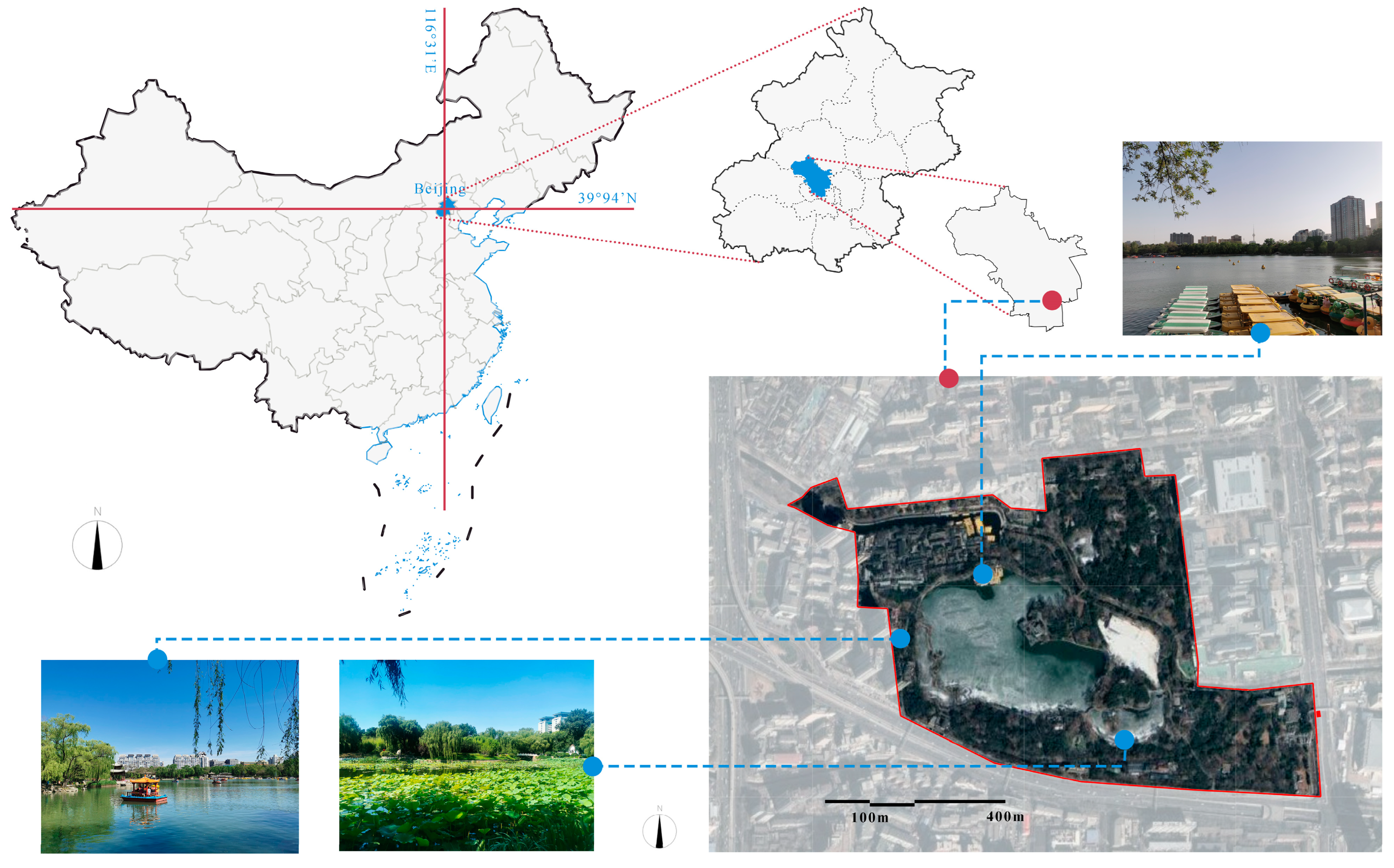
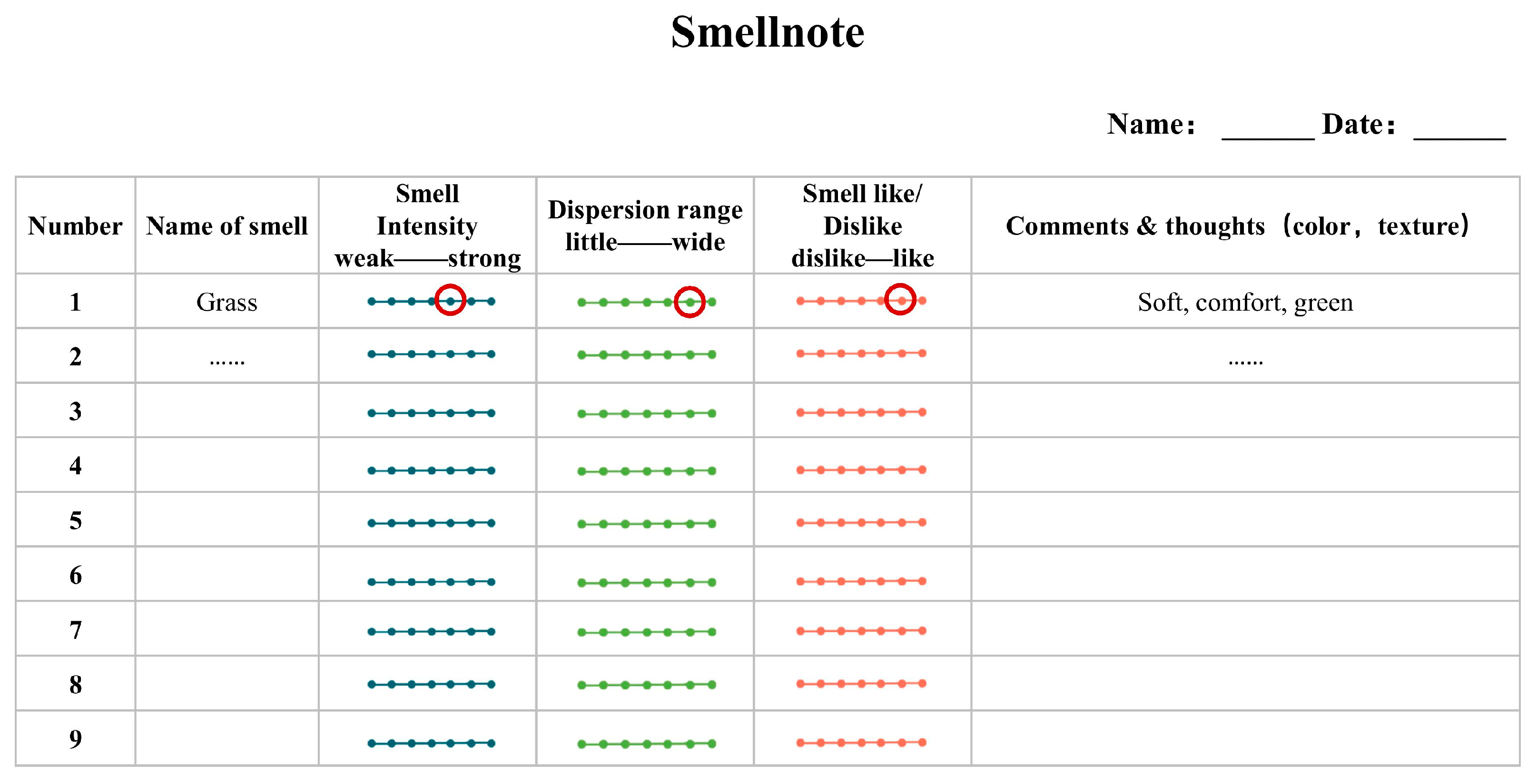
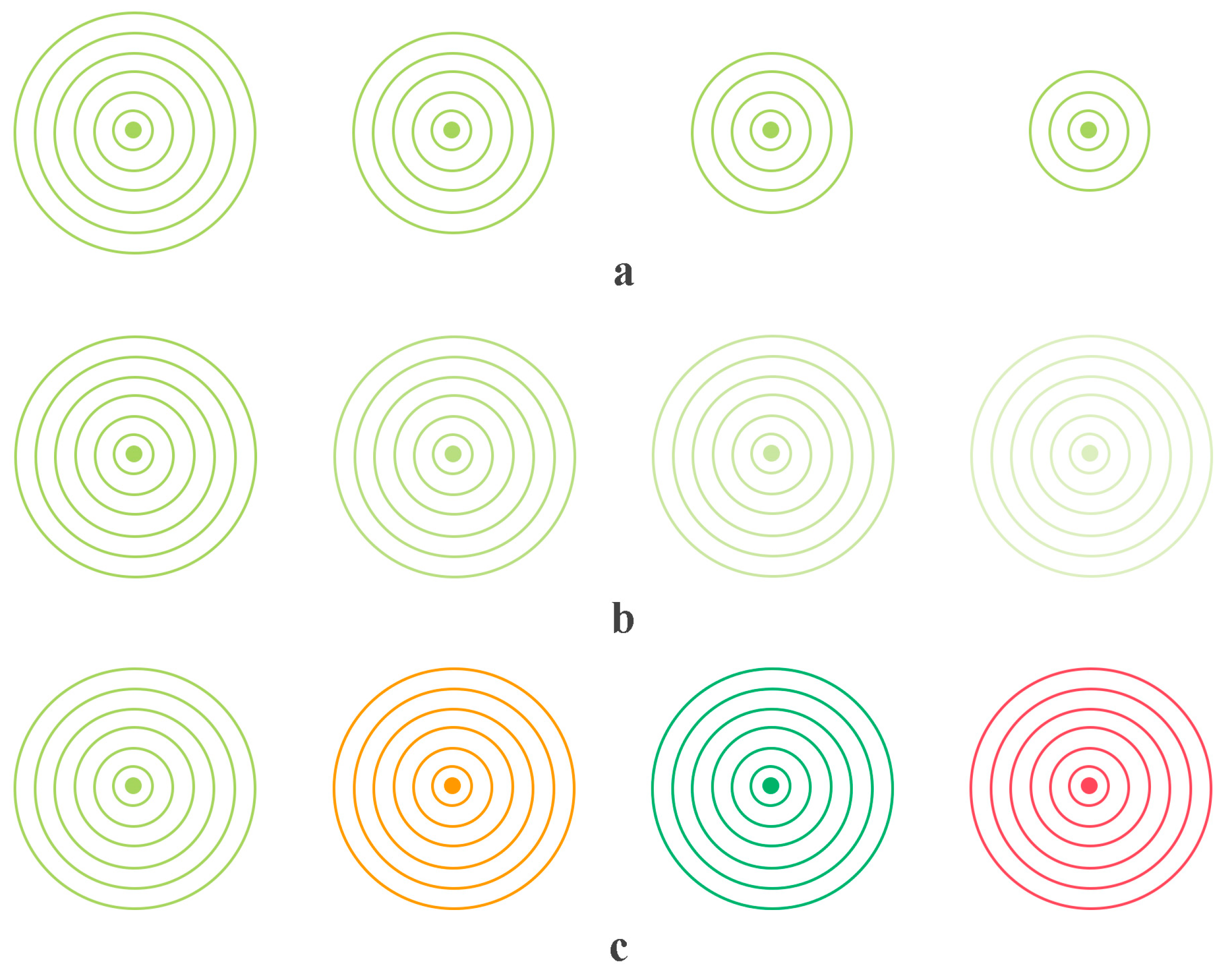
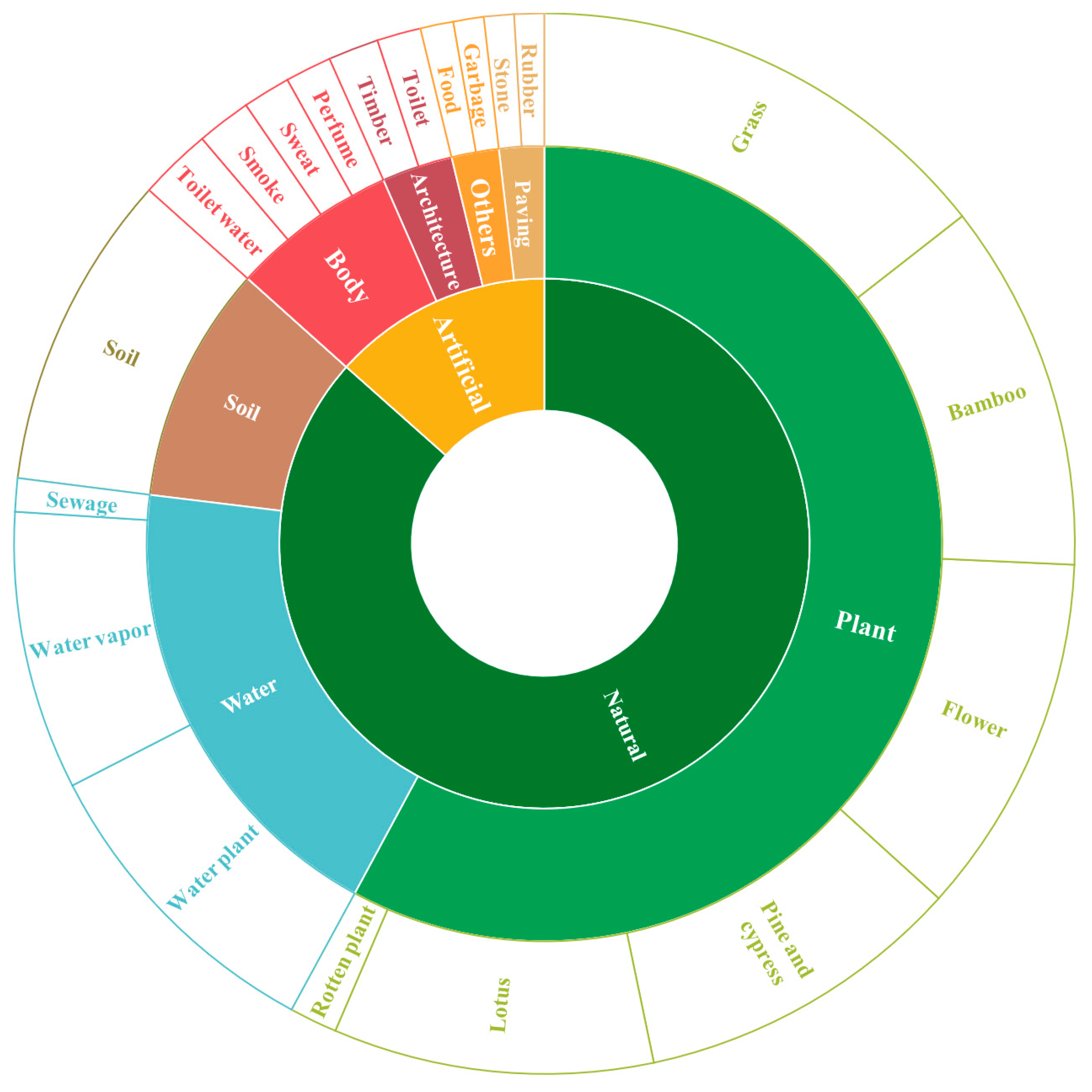
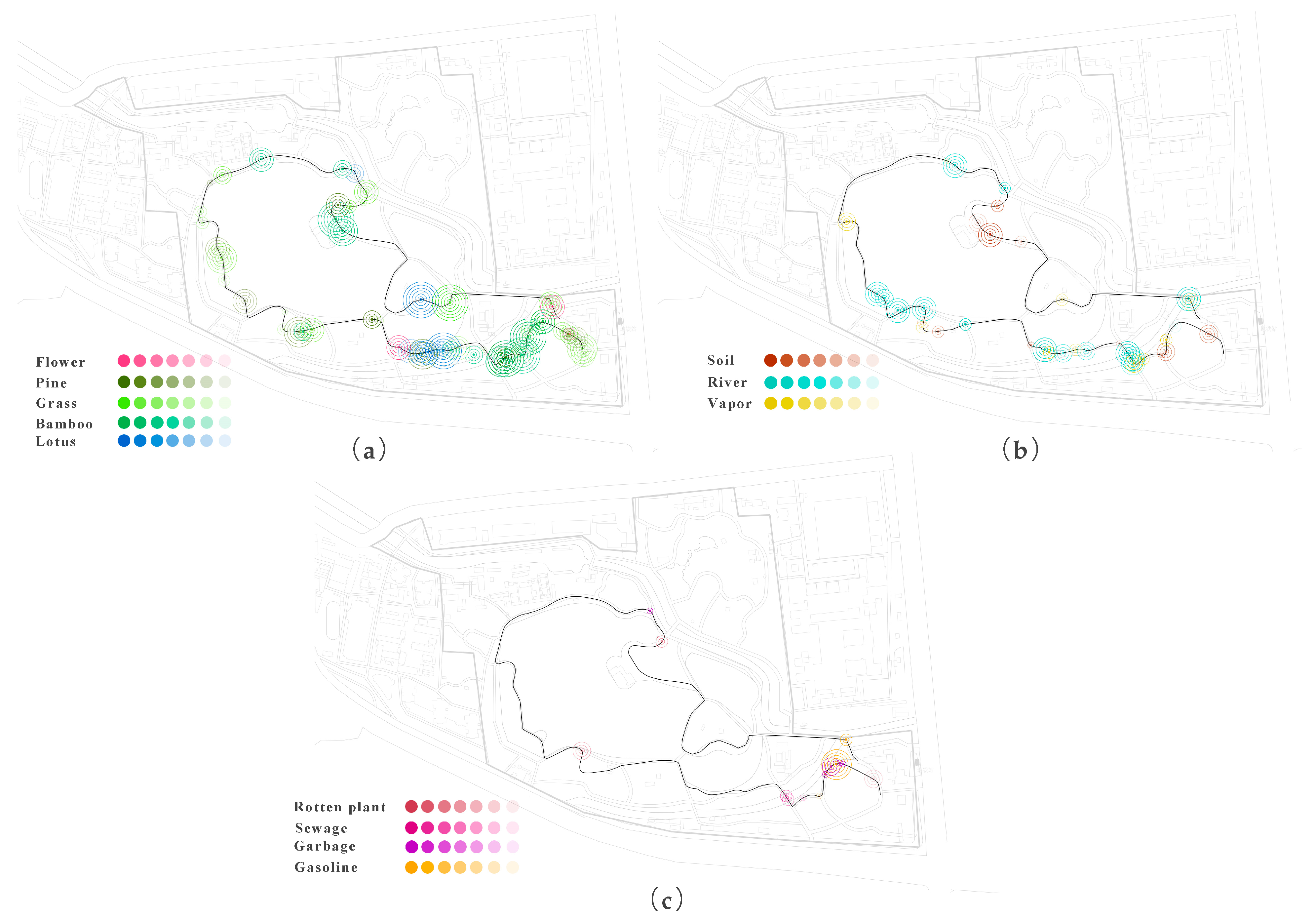
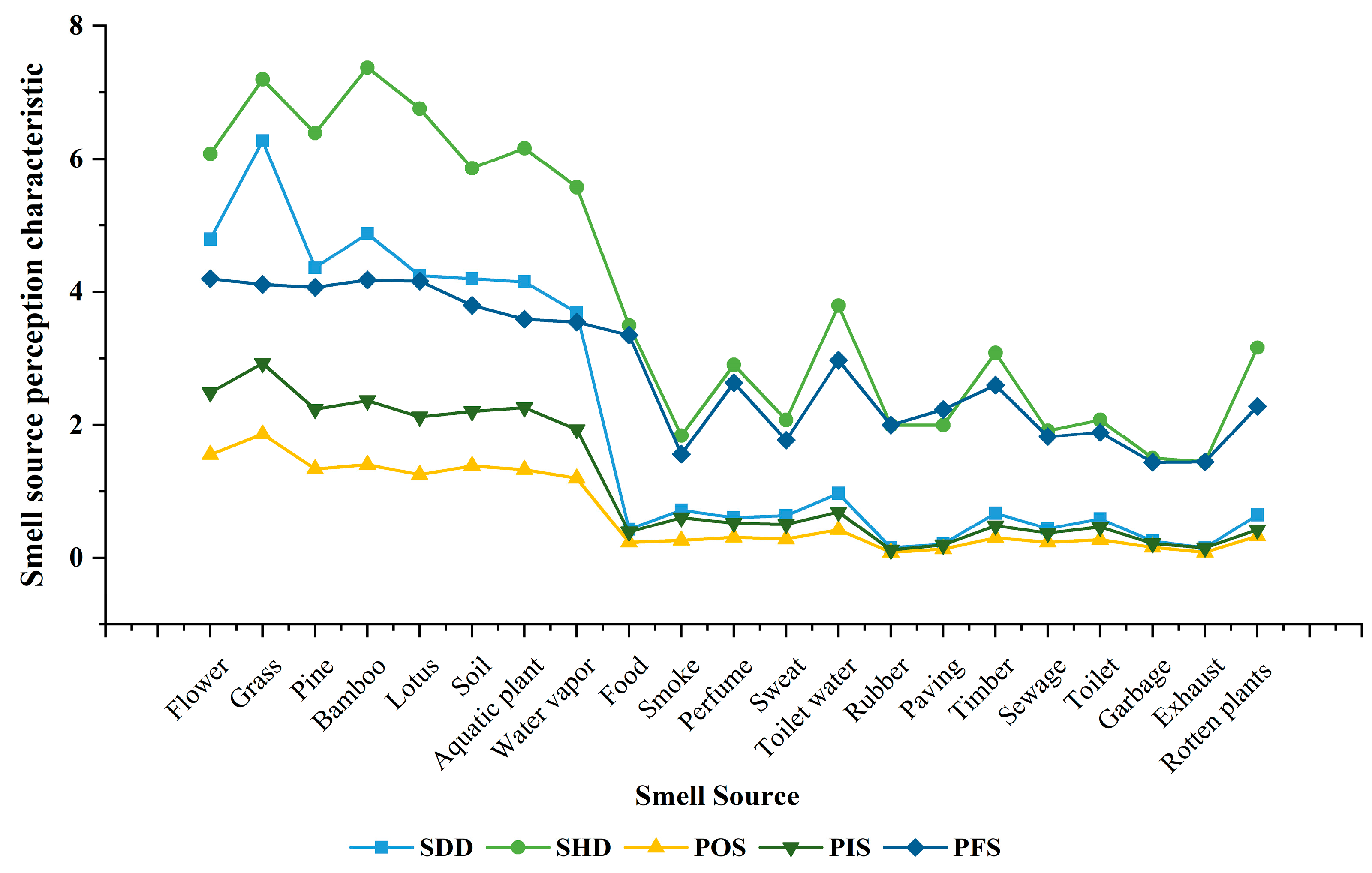
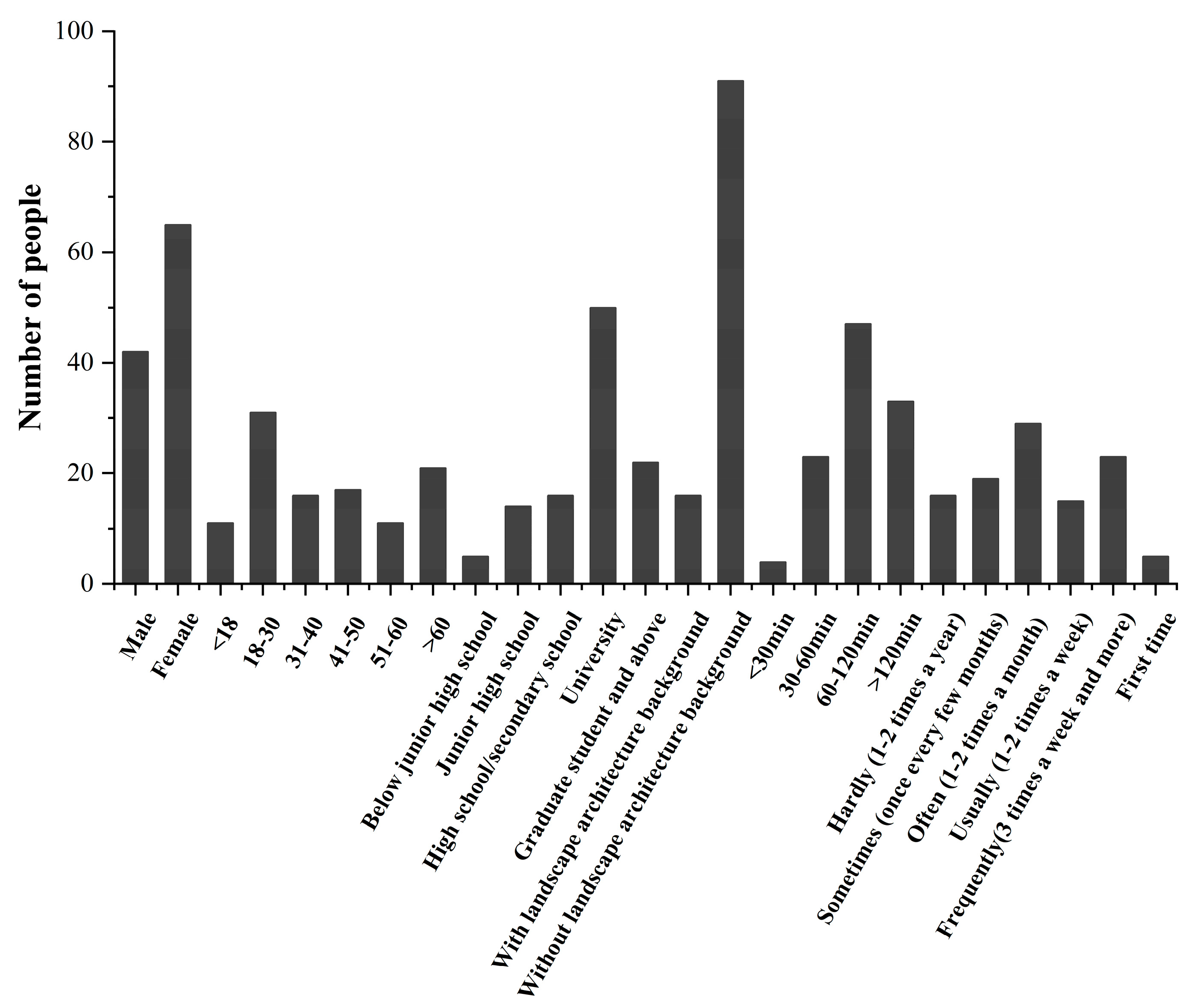
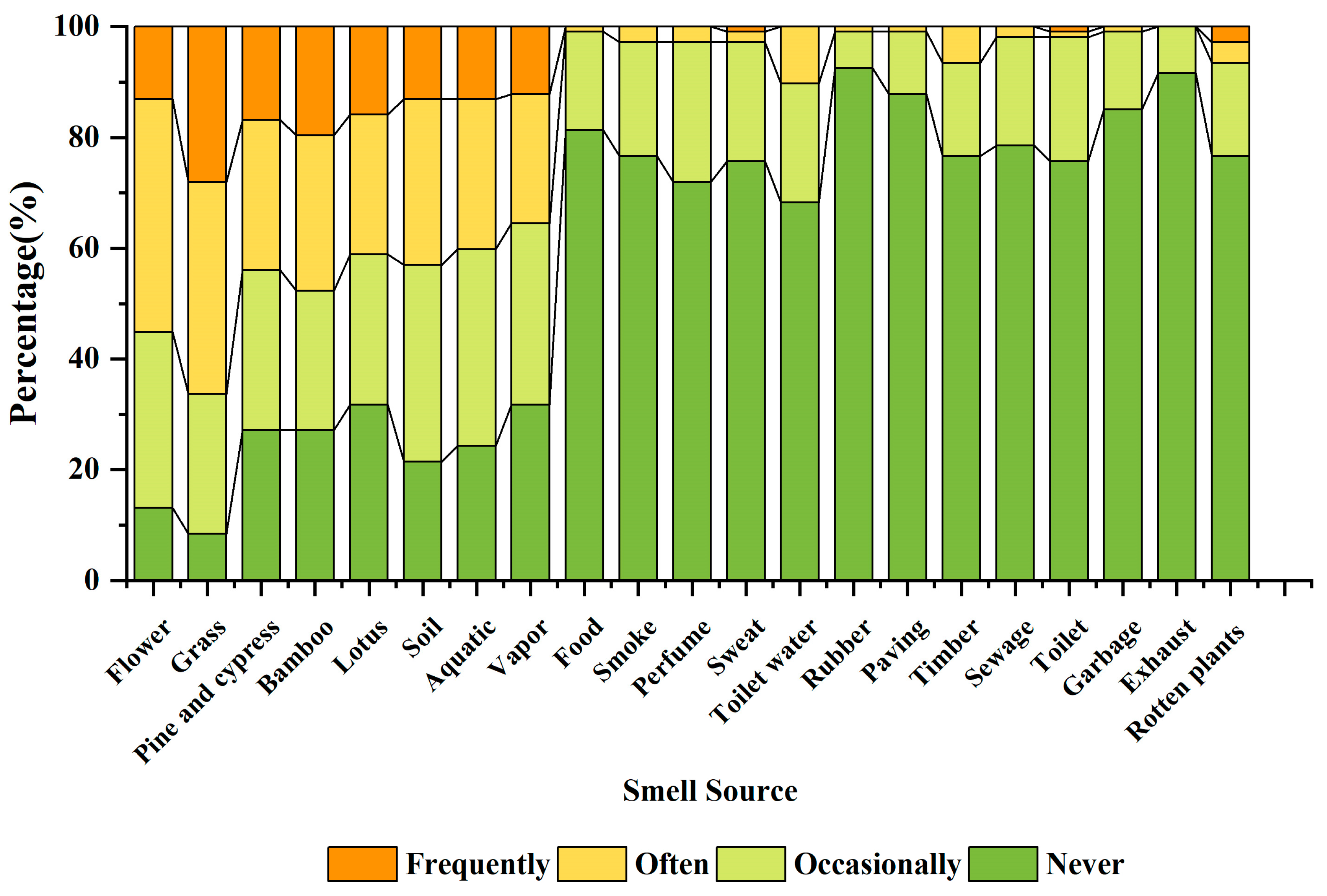
| Class | Subclass | Smell Source Name | |
|---|---|---|---|
| Natural | Plant | Flowers, grass, pine and cypress, bamboo, lotus | Rotten plant |
| Soil | Soil | ||
| Water | Water plants, water vapor | Sewage | |
| Artificial | Architecture | Timber | Toilet |
| Paving | Rubber, stone | ||
| Body | Perfume, toilet water | Smoke, sweat | |
| Others | Food | Garbage, exhaust |
| Experience Degree | POS | PIS | PFS | SDD | SHD |
|---|---|---|---|---|---|
| visual experience degree | grass (0.230 *) 1 | grass (0.274 **) | bamboo (0.338 **) | grass (0.247 *) | aquatic (0.240 *) |
| pine and cypress (0.322 **) | |||||
| aquatic (0.287 **) | |||||
| flowers (0.285 **) | |||||
| lotus (0.240 *) | |||||
| olfactory experience degree | flowers (0.386 **) | flowers (0.266 **) | lotus (0.303 **) | flowers (0.346 **) | flowers (0.368 **) |
| grass (0.211 *) | pine and cypress (0.301 **) | lotus (0.243 *) | |||
| soil (0.227 *) | pine and cypress (0.232 *) | ||||
| flowers (0.213 *) | |||||
| overall experience degree | flowers (0.202 *) | grass (0.193 *) | flowers (0.437 **) | sweat (−0.194 *) | flowers (0.361 **) |
| sweat (−0.195 *) | bamboo (0.340 **) | ||||
| lotus (0.304 **) | |||||
| pine and cypress (0.236 *) |
| Experience Degree | Visual Experience Degree | Olfactory Experience Degree | Overall Experience Degree |
|---|---|---|---|
| visual experience degree | 1 | - | - |
| olfactory experience degree | 0.572 ** | 1 | - |
| overall experience degree | 0.734 ** | 0.667 ** | 1 |
| Social/ Demographic/ Behavioral Indicators | POS | PIS | PFS | SDD | SHD |
|---|---|---|---|---|---|
| education | toilet (0.259 **) 1 | toilet (0.257 **) | - | toilet (0.257 **) | - |
| visit duration | soil (0.198 *) | soil (0.235 *) | - | soil (0.223 *) | - |
| visit frequency | grass (0.205 *) | toilet water (0.254 **) | smoke (0.474 *) | toilet water (0.251 **) | grass (0.200 *) |
| smoke (0.195 *) | |||||
| toilet water (0.233 *) |
Disclaimer/Publisher’s Note: The statements, opinions and data contained in all publications are solely those of the individual author(s) and contributor(s) and not of MDPI and/or the editor(s). MDPI and/or the editor(s) disclaim responsibility for any injury to people or property resulting from any ideas, methods, instructions or products referred to in the content. |
© 2023 by the authors. Licensee MDPI, Basel, Switzerland. This article is an open access article distributed under the terms and conditions of the Creative Commons Attribution (CC BY) license (https://creativecommons.org/licenses/by/4.0/).
Share and Cite
Wang, C.; Zhu, R.; Zhong, J.; Shi, H.; Liu, C.; Liu, H.; Tan, B.; Xiang, L.; Xiang, R.; Ye, X.; et al. Smellscape Characteristics of an Urban Park in Summer: A Case Study in Beijing, China. Sustainability 2024, 16, 163. https://doi.org/10.3390/su16010163
Wang C, Zhu R, Zhong J, Shi H, Liu C, Liu H, Tan B, Xiang L, Xiang R, Ye X, et al. Smellscape Characteristics of an Urban Park in Summer: A Case Study in Beijing, China. Sustainability. 2024; 16(1):163. https://doi.org/10.3390/su16010163
Chicago/Turabian StyleWang, Chen, Ruolin Zhu, Jian Zhong, Huajin Shi, Chang Liu, Huiyu Liu, Bohao Tan, Lijuan Xiang, Ruizi Xiang, Xinru Ye, and et al. 2024. "Smellscape Characteristics of an Urban Park in Summer: A Case Study in Beijing, China" Sustainability 16, no. 1: 163. https://doi.org/10.3390/su16010163
APA StyleWang, C., Zhu, R., Zhong, J., Shi, H., Liu, C., Liu, H., Tan, B., Xiang, L., Xiang, R., Ye, X., & Sun, M. (2024). Smellscape Characteristics of an Urban Park in Summer: A Case Study in Beijing, China. Sustainability, 16(1), 163. https://doi.org/10.3390/su16010163






